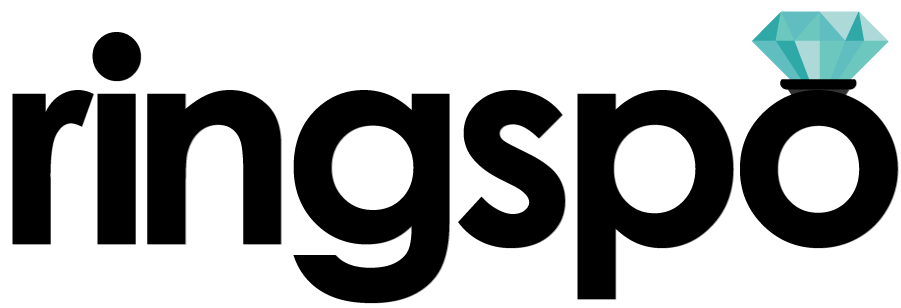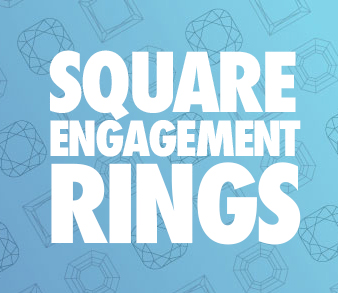Square engagement rings
Everything you need to know about square shaped diamond engagement rings
Ringspo is reader supported
Ringspo is reader-supported, which means we may receive a commission if you click a link to a retailer & subsequently make a purchase.
We feature links to several retailers to help readers find the one that is the best fit for them. Find out more about how Ringspo works here.
If you’re searching for a striking alternative to the prolific round diamond engagement ring, a square engagement ring with a square shaped diamond can be a great answer to your quest. Whether you want a ring with blingy sparkle accented with multiple diamonds, a timeless solitaire, or a classic antique style, square engagement rings offer a different spin on some old favorites.
Many shoppers incorrectly call them square cut diamonds, but there’s actually no such thing as a square cut diamond. Instead there are diamonds cut into to a square shape. A subtle, but important distinction!
Square shaped diamonds are broken down into different cuts, the most popular of which is the princess cut. The other two square shaped diamonds are the cushion cut and the asscher cut.

Princess cut square diamond ring
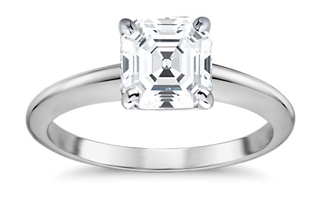
Asscher cut square diamond ring
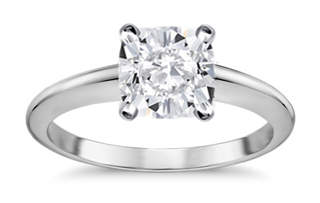
Cushion cut square diamond ring
In this article, you’ll learn:
- Square shaped diamond options
- Key characteristics and benefits of each cut
- Styles of square shaped engagement rings
- We’ll compare and contrast the square shaped diamonds to find out which one is right for you
Diamond facets and cut styles
All diamonds have polished, flat surfaces that enable the diamond to reflect light (known as ‘facets’), but not all diamonds work in the same way to reflect light. There are three types of faceting arrangements diamond cutters use:
- Brilliant cut – the facets radiate out symetrically from the center of the diamond to the outer edges
- Step cut – facets are long, flat, parallel rows that resemble stairs
- Mixed cut – a mix – one half of the diamond is cut as a brilliant cut and the other half is cut as a step cut
The diamonds used in square shaped diamond engagement rings are either brilliant cut or stepped cut.
1. Princess Cut Square Engagement Rings
Second only in popularity to round brilliant cut diamonds, square shaped princess cuts are loved for a good reason. While the style was originally created in the ‘60s, it wasn’t until the ‘80s that diamond cutters worked out how to use finely-calibrated lasers to perfect the dimensions of the princess cut to ensure they reflect as much light as possible in the form of fire and brilliance.

Not only did cutters present the diamond market with a new contender to the crown of the round brilliant, cutters could salvage more of the original diamond rough crystal by cutting the diamond into a square shape. This leading to a lower price point. The factors of shape, brilliance, and price make the princess cut diamond a favorite with engagement ring shoppers.
Princess cut engagement rings shape and brilliance
Once the princess cut started gaining popularity, cutters around the world dubbed it the ‘princess cut.’ However, its technical name is actually the decidedly less snappy ‘modified square brilliant cut,” which is the term you will see on every GIA report that accompanies a princess cut diamond.
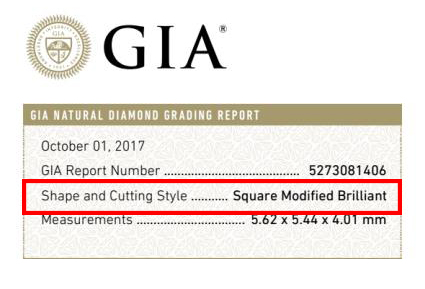
Viewing the diamond report, you’ll see the measurements of the diamond listed. The most desirable princess cuts are the ones that are the squarest with a length to width ratio (length divided by width) of 1.00 to 1.05. If the princess cut’s dimensions fall outside of these parameters, it’s likely that the diamond will be noticeably more rectangular-looking and therefore not as desirable. However, these more rectangular-shaped princess cuts are priced lower – usually by around 10%.
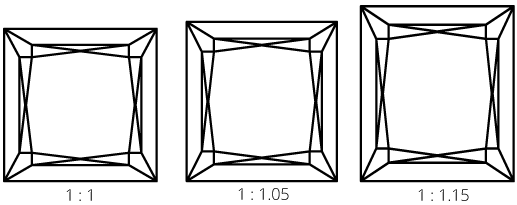
As well as being the second most popular shape of diamond, princess cuts are also deliver the second best sparkle. Only the round cut diamond can best a princess cut in the blinding brilliance department, but the princess cut gives it a run for its money.
This brilliance is a two-fold bonus – not only is it dazzling the eye, but it also helps mask any warmer body colors in the diamond, tricking the eye into believing the diamond is a higher color grade than it really is.
Princess cut diamond price
While the price of a princess cut square diamond ring will depend on many factors, including the quality of the stone and the setting chose, this table gives you a general guide to the price of princess cut diamonds, with the following characteristics:
- Color: G
- Cut: Ideal
- Clarity: VS2
The guidance price is below:
| Carat weight | Price (US$) |
| 0.5 carat | $1,500 |
| 0.75 carat | $3,250 |
| 1 carat | 4,500 |
| 1.5 carat | 12,000 |
You can check up to exact and date prices for princess cut diamonds here.
These prices are significantly lower than the price of a round brilliant diamond. One reason for its lower price is round brilliant cuts are more in demand. The second reason for its lower price point is that diamond cutters don’t lose as much weight from the original rough diamond when fashioning a princess cut.
Diamond cutters try to yield the largest polished diamond possible from an original diamond crystal. Round brilliant cut diamonds result in around 40-50% of a diamond’s original surface being lost. However, fashioning a princess cut results in a loss of only 20% of the original crystal, meaning that diamond cutters can get more bang for their buck, which translates into savings for you.
2. Asscher cut square engagement rings
The second square cut engagement ring option we’re going to look at is a ring containing an asscher cut diamond.
Unlike the princess and cushion cuts, the asscher cut uses a ‘step cut’ facet arrangement. Another well-known step cut diamond is the emerald cut diamond which is rectangular in shape. In essence, the asscher cut is a square emerald cut diamond, but with more facets (58 total), a smaller table (the largest facet on top of the diamond), and a deeper depth.
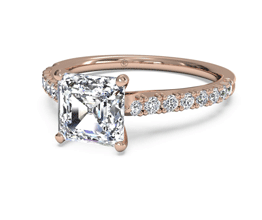
In fact, the Asscher cut is actually known as a ‘square emerald cut’:
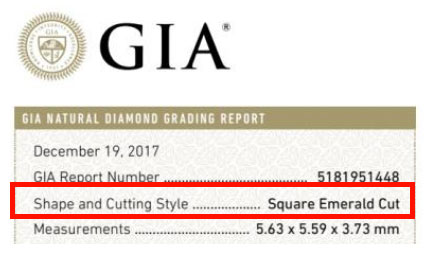
The Asscher cut was introduced in the early 1900’s by the Royal Asscher Diamond Company, but the cut didn’t become popular in jewelry until the 1920’s. 1920 to 1930 spanned the Art Deco age of jewelry which featured geometric patterns and bold, clean lines. With its crisp, angular shape and linear facet arrangement, the step cut diamond epitomized the Art Deco style and the asscher cut surged in popularity.
With the current trend for antique-style engagement, the asscher cut is experiencing renewed popularity with square engagement ring shoppers. In fact, in 2001, the Royal Asscher Company recut their original design to include additional facets, bringing the facet total to 74. Called The Royal Asscher Cut, the diamond is patented and is only sold by selected retailers.
Asscher cut square engagement ring shape and brilliance
The asscher cut is a step cut with its corners beveled. In fact, the corners are docked so significantly that it looks almost octagonal when it’s loose and not in a ring mounting. Once set with prongs wrapped around the four corners, the asscher looks cleanly square.

As a step cut, the asscher manipulates light reflection differently than the brilliant cuts of the cushion and princess. Its facets create a ‘hall of mirrors’ effect with reflected light and distributes it as a sleek glint rather than a rainbow dispersion seen in brilliant cuts. For a classic look, the asscher cut is a glamorous choice without being too brash.
Something to be wary of with the Asscher cut is that because the facets create a mirror-like effect through the diamond, inclusions may be more visible:

Also, as the asscher doesn’t disperse light as a brilliant cut diamond does, it doesn’t hide the body color of the diamond like a princess cut diamond will. Keeping these attributes in mind, I recommend a VS2 or higher clarity grade and a G or higher color grade.
Asscher cut diamond price
Because it’s not a mainstream cut, the asscher cut is not as expensive as its other square counterpart, the princess cut. However, few jewelry houses carry this classy cut, so the low supply elevates the price higher than the cushion’s price. Compared to the price of a round brilliant cut, choosing an asscher cut can save you about 40%.
While the price of an asscher cut square diamond ring will depend on many factors, including the quality of the stone and the setting chosen, this table gives you a general guide to the price of asscher cuts, with the following characteristics:
- Color: G
- Clarity: VS2
The guidance prices are:
| Carat weight | Price (US$) |
| 0.5 carat | $1,200 |
| 0.75 carat | $2,000 |
| 1 carat | $4,000 |
| 1.5 carat | $8,750 |
You can check out today’s prices here.
3. Cushion Cut Square Engagement Rings
The final square shaped engagement ring we’re going to look at is the cushion cut engagement ring. A cushion cut diamond is a perfect option for someone who can’t decide between the round and the princess cut diamond. Unlike the pointed corners of the princess cut, the cushion cut has a softly rounded square shape. Some say it resembles a pillow, hence its name.

Cushion cut square engagement ring
Technically, a cushion cut diamond is a combination of the round brilliant cut and an antique diamond cut called the ‘old mine cut’, which isn’t commonly used in modern jewelry.
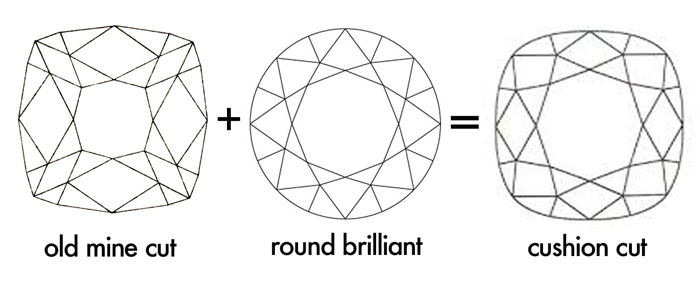
The old mine cut diamond harkens back to days of yore – a time before before lasers and computers – when diamonds were cut with the naked eye and a steady hand. Found most often in jewelry from the Georgian and Victorian Era (1714-1901), the old mine cut has a square shape as diamond cutters from that period tried to retain as much of the original diamond.
The modern cushion cut is a great marriage between the nostalgia of the old mine cut and the sparkle the round brilliant cut. On GIA grading reports, older cushion cuts are simply called ‘cushion brilliant cuts’, while newer cushion cuts are called ‘cushion modified brilliant cuts.’ When shopping, you will see that both are found under the category of cushion cut regardless of what’s on the GIA diamond grading report.

The cushion is sought after for its shape rather than its sparkle, which will be significantly less than the princess cut. Because they don’t sparkle as much, cushions will not mask warmer body colors like the princess cuts can. I recommend a G color grade or higher when shopping for cushion cuts simply because it could appear warmer in lower color grades.
Square vs. rectangular cushion cut diamonds
Like princess cuts, cushion cuts can also be rectangular. However, Unlike princess cuts, the most popular cushion cuts are bit more rectangular. Usually a length to width ratio (length divided by width) of 1.10 to 1.20 is the most desirable, but personal preference should dictate the one you desire.
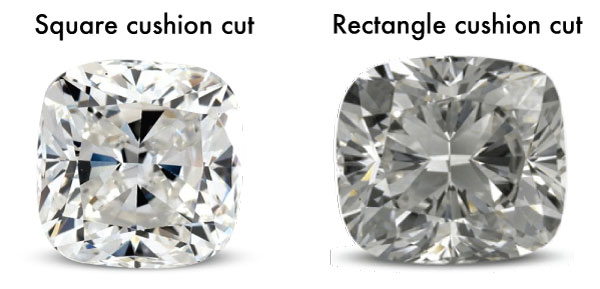
Because there are no industry-specified dimensions of cushion cut diamond that have been determined to enhance brilliance, diamond cutters focus on keeping a pleasing shape when fashioning a cushion cut.
Cushion cut diamond price
Because they’re not as popular as the princess cut, cushion cut diamonds will be less expensive than a princess cut of the same color, clarity, and carat weight. However, with the increase in popularity of antique style engagement rings, the cushion cut is gaining traction with shoppers looking for a square shaped engagement ring.
While the price of a cushion cut square diamond ring will depend on many factors, including the quality of the stone and the setting chose, this table gives you a general guide to the price of cushion cut diamonds, with the following characteristics:
- Color: G
- Clarity: VS2
The guidance prices are:
| Carat weight | Price (US$) |
| 0.5 carat | $1,000 |
| 0.75 carat | $1,800 |
| 1 carat | $3,700 |
| 1.5 carat | $8,000 |
You can check up the exact prices for cushion cut diamonds here.
Princess Cut vs Asscher Cut
While both have an angular and geometric appeal, the differences in the faceting arrangements gives the princess cut a modern, splashy style while the asscher cut has a classic vintage flair. Knowing which of these appeals to you should help guide your choice on which diamond shape is right for your square cut engagement ring.

Princess cut

Asscher cut
Which sparkles more – princess cut or asscher cut?
The differences in sparkle is a major point of contrast between the princess cut and the asscher cut.
The added bonus of the brilliance of the priness cut is that it masks a warmer body color and possible inclusions in the diamond.
On the other hand, the Asscher’s step cut will reveal its crystalline precision as well as any inclusions and body color in the diamond.
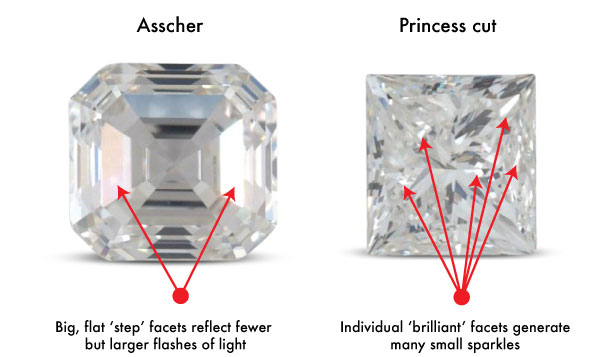
Which looks bigger – asscher cut or princess cut?
The princess cut carries some of its weight in the corners of the stone and is also usually cut deeper than the Asscher cut, which means that there is less of the carat weight to spread out across the surface area of the diamond.
As a result, Asscher cuts are usually wider than princess cuts when viewed from the top, with about 7% more surface area.

Which is more durable – princess cut or asscher cut?
With its pointed corners, the princess cut has four points that are durability concerns.
The fragile tips are thin and prone to chipping, so care should be taken. Without these delicate points, the asscher cut is a bit more durable
Which is more expensive – asscher cut or princess cut?
Due to its popularity, the princess cut will edge out the asscher with a higher price. However, because the asscher’s faceting arrangement isn’t as forgiving as the princess cut’s, a diamond of a higher color and clarity should be purchased, at least G color grade and a VS2 clarity grade.

Princess Cut vs. Cushion Cut Square Engagement Rings
While the princess cut and the cushion cut are similar in shape, there are a few differences to keep in mind when deciding between the two.
Which sparkles most – princess cut or cushion cut?
The sparkle of the princess cut rivals the brilliance of the round brilliant cut while the cushion has a more subdued brilliance. This brilliance helps the princess cut mask a warmer body color than will the cushion cut. An H color grade princess cut will look whiter than an H color grade cushion cut, so buy a higher color grade in cushion than you would a princess cut.
The cushion is admired for its vintage look while the princess’s precise angles gives it a modern flair.
Which is more durable – princess cut or cushion cut?
Durability is an important consideration with a square cut engagement ring if it’s going to be worn every day.
Princess cuts’ corners are pointed and thin, which can pose a durability risk and mean that greater care should be taken with them compared to less sharp diamond shapes. Although the prongs that hold the diamond in the setting will protect the corners, they’re still a fragile part of the diamond. In comparison, the cushion cut’s corners are rounded, they pose no durability issues like the princess cuts.
Which looks bigger – princess cut or cushion cut?
The princess cut and the cushion cut are very similar in visible surface area. The princess cuts may have a tendency to look larger because their corners extend farther than the cushion cut.

Which costs more – princess cut or cushion cut?
Here’s a side by side comparison of a princess cut and a cushion cut from one of my recommended retailers. The diamonds have the same carat weight, color grade, clarity while the price is significantly different. If you are looking for a square shaped engagement ring that fits your budget, the cushion shape offers a great value.

Asscher Cut vs Cushion Cut
Both of these square beauties are reminiscent of vintage cutting styles and are sought after for it. More so than their brilliance, the asscher cut and the cushion cut are popular for the way their shape complements antique style engagement rings.

There are a few differences to keep in mind:
Which sparkles most – cushion cut or asscher cut?
These two diamonds have completely different faceting arrangements and will yield completely different levels and styles of brilliance.
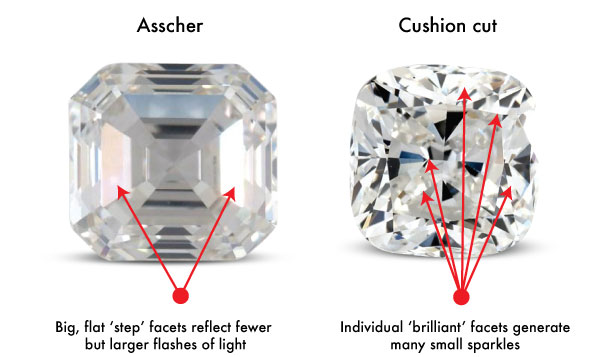
As a step cut, the asscher’s elongated facets will produce a muted reflection of light while the multiple facets of the brilliant cut princess will produce a sparkling rainbow of brilliance. However, the asscher cut’s muted brilliance will not mask inclusions or warmer body colors as the cushion cut will.
Which is more durable – cushion cut or asscher cut?
With their beveled and rounded corners, both the asscher cut and the cushion cut pose few durability problems. Care should always be taken with diamonds, but both styles will hold up well through the years.
Which looks bigger – asscher cut or cushion cut?
With their corners trimmed, the asscher cut and the cushion cut will face up with similar surface area. To enhance the mirror-like effect of its facet arrangement, the asscher will sometimes have a deeper depth than the cushion.
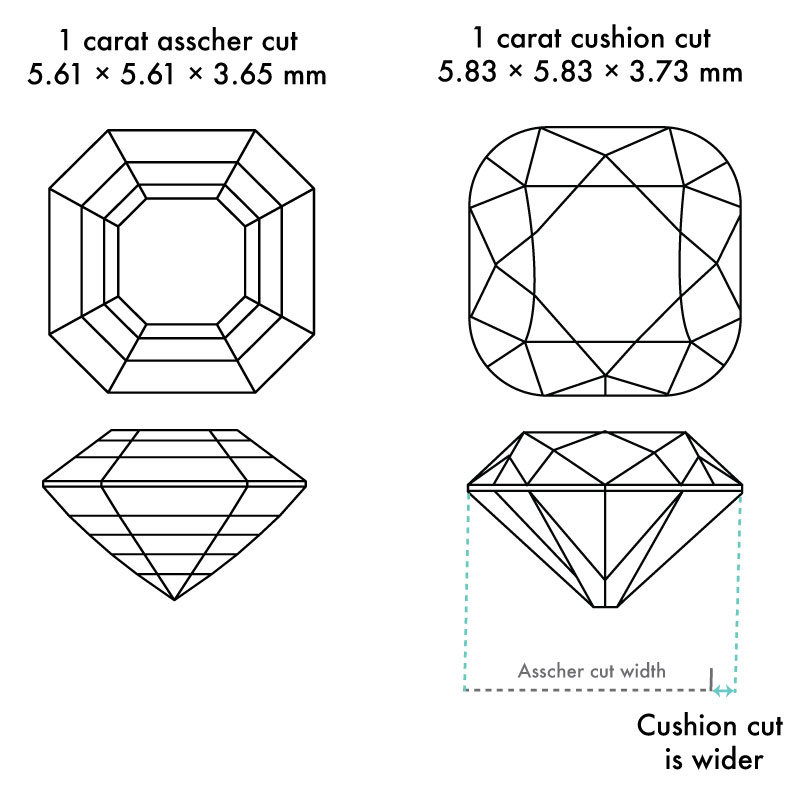
Which is more expensive – asscher cut or cushion cut?
The precise angles of the of the asscher, as well as its limited supply, mean that it is a pricier choice than the cushion cut.
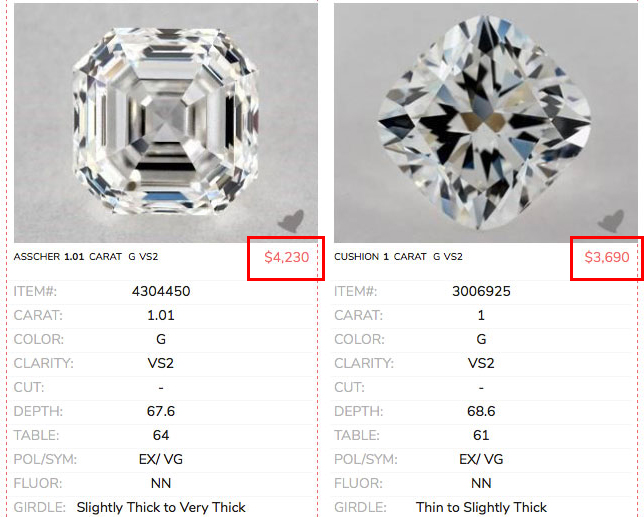
Which square shape is right for you?
Deciding which square shaped engagement ring is the right one for you is a purely personal choice. Hopefully this page has help you with your decision. If you have any questions at all then please don’t hesitate to drop me a line and I will be happy to help you out.
